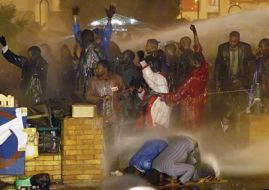Egypt urged to probe seriously killing of Sudanese in 2005
December 29, 2007 (CAIRO) -– Five Egyptian and international human rights organizations today called on President Hosni Mubarak to authorize an independent judicial inquiry into the December 30, 2005 police assault on Sudanese protestors – refugees, asylum seekers and migrants – in Cairo that resulted in the deaths of 27 persons and injured scores more.
 Amnesty International, Human Rights Watch, the Egyptian Initiative for Personal Rights, Hisham Mubarak Law Center and the Nadim Center for Rehabilitation of Victims of Violence said that an independent judicial inquiry should also examine the conduct of the initial investigation into the incident by the Dokki Prosecution Office, which found no evidence of police or official misconduct. The groups reviewed a copy of that initial investigation and found a concerted effort to absolve the police of any wrongdoing.
Amnesty International, Human Rights Watch, the Egyptian Initiative for Personal Rights, Hisham Mubarak Law Center and the Nadim Center for Rehabilitation of Victims of Violence said that an independent judicial inquiry should also examine the conduct of the initial investigation into the incident by the Dokki Prosecution Office, which found no evidence of police or official misconduct. The groups reviewed a copy of that initial investigation and found a concerted effort to absolve the police of any wrongdoing.
“President Mubarak should use the second anniversary of the police action against Sudanese protestors to initiate a complete and transparent investigation of what really took place,” said Joe Stork, deputy director of Human Rights Watch’s Middle East division. “The public prosecutor’s total exoneration of the police lacks any semblance of credibility.”
In the early hours of December 30, 2005, a force of nearly 4,000 Egyptian police and security officers surrounded a makeshift camp in Mustafa Mahmoud Square in Cairo’s Mohandisin neighborhood, near the offices of the United Nations High Commissioner for Refugees, where for three months hundreds of Sudanese refugees, asylum seekers, and migrants had engaged in a peaceful sit-in protest.
According to media accounts at the time, police fired from water cannons into the crowd and then entered in force, beating people indiscriminately. The episode resulted in the deaths of at least 27 of the Sudanese, including 11 children and eight women. An investigation by the public prosecutor’s office in Dokki concluded in May 2006 that all the deaths “resulted from a stampede,” and found no wrongdoing on the part of the police.
The government never made public the written decision to close the investigation, but the five groups recently obtained a copy of the decision (http://hrw.org/pub/2007/mena/dokkiNyabaDecisionMustafaMahmud.pdf)
The government’s initial “no fault” conclusion appears in a 16-page memorandum dated May 20, 2006 and signed by Wael Hussein, chief of the Dokki Prosecution Office. The memorandum reveals serious failures in the official investigation into the killings, and shows how the public prosecutors and state forensic doctors collaborated to absolve the police from any responsibility for the 27 deaths.
For example, the memorandum states that none of the police officers and security officials interviewed by public prosecutors was able to name the official who issued the order to launch the operation or the security official who led the anti-riot force responsible for carrying it out.
The memorandum shows that public prosecutors made no serious effort to investigate this apparent attempt to protect those responsible for ordering the attack on the protestors, the five groups said.
Prosecutors also interviewed four eyewitnesses who all claimed that the protestors initiated the violence by attacking the police. The government put the total number of protestors at 1,107, and at least 650 protestors were in state custody for several weeks following the assault, but prosecutors managed to interview only one Sudanese woman who was injured in the attacks.
“Prosecutors were clearly more interested in protecting the police and vilifying the victims than in establishing the truth of what really happened on December 30,” said Hassiba Hadj Sahraoui, deputy director of Amnesty International’s Middle East and North Africa program.
The memorandum also shows how Justice Ministry forensic experts endeavored to obscure any criminal responsibility for the deaths. The autopsy reports cite marks of “injuries resulting from crashing against solid, rough-surfaced objects,” a death resulting from “bruises in the head and neck leading to a brain concussion and a failure of higher vital brain centers,” and another death “resulting from a head injury leading to nerve fiber injuries.”
The forensic experts nonetheless concluded that all the deaths resulted from a “stampede” leading to asphyxia, and claimed there was “a lack of any signs indicating the use of excessive force in assaulting them.”
Chief Prosecutor Wael Hussein relied on these forensic reports and on the statements of police officers to conclude that there was “absolutely no relation between the deaths and the conduct of police forces in dispersing the protestors.”
Citing “lack of evidence,” Hussein decided to exclude the charge of premeditated murder, they said.
Instead, the chief prosecutor charged the protestors en masse with committing crimes of manslaughter, unintended injury, resisting authorities, and the deliberate destruction of property.
“Charging the protestors with serious crimes and exonerating the police of any wrongdoing is the absurd but inevitable outcome of a sham investigation,” said Hossam Bahgat, director of the Egyptian Initiative for Personal Rights. “Two years after their deaths, the victims of police brutality in Mustafa Mahmoud Square still await justice.”
In April 2007, the UN Committee on the Rights of Migrant Workers requested that the investigation into the killings “be reopened in order to clarify the circumstances leading to the deaths of the Sudanese migrants.
(ST)
On the Net: For background information on the events of December 30, 2005.
– http://hrw.org/english/docs/2005/12/30/egypt12353.htm
– http://www.amnesty.org/en/alfresco_asset/afc32f81-a477-11dc-bac9-0158df32ab50/mde120022006en.html
